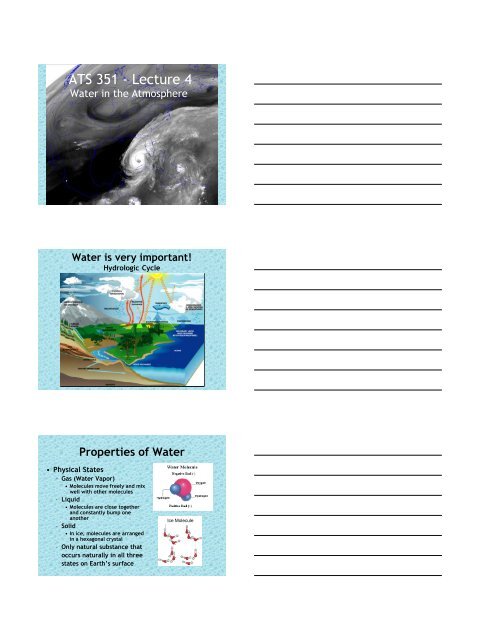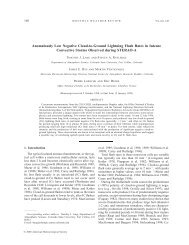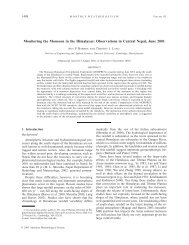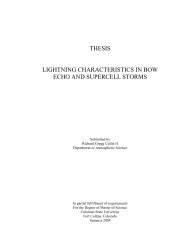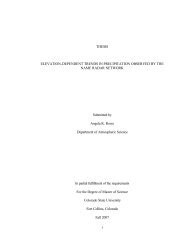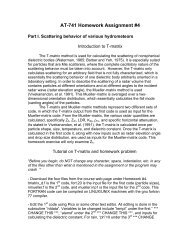ATS 351 - Lecture 5
ATS 351 - Lecture 5
ATS 351 - Lecture 5
You also want an ePaper? Increase the reach of your titles
YUMPU automatically turns print PDFs into web optimized ePapers that Google loves.
2/2/2010<strong>ATS</strong> <strong>351</strong> - <strong>Lecture</strong> 4Water in the AtmosphereWater is very important!Hydrologic CycleProperties of Water• Physical States(Vapor – Gas (Water• Molecules move freely and mixwell with other molecules– Liquid• Molecules are close togetherand constantly bump oneanother– Solid• In ice, molecules are arrangedin a hexagonal crystal– Only natural substance thatoccurs naturally in all threestates on Earth’s surfaceIce Molecule1
2/2/2010Phases of Water• Condensation• Evaporation• Melting• Freezing• Sublimation– Molecules have enoughenergy to escape from thesurface of ice into air aboveand directly into the vaporphase• Deposition– Water vapor moleculeattaches itself to an icecrystal and changes to iceEvaporation• Water has a very high surfacetension– Takes energy to break thehydrogen bonds on a watersurface in order to evaporate• What can enhance evaporationfrom the surface of water?– When temperatures are increases,molecules move faster (gain energy)and can break the surface tensionmore easily– Wind also enhances evaporationCondensation• Depends on temperature– For condensation to be really effective,water vapor needs something to condenseonto.– We call these things in air CondensationNuclei.• Dust, smoke, salts, other particles…• When air is warm and molecules movefast, water vapor may bounce off theCondensation Nuclei.• When air is cold and molecules movemore slowly, water vapor is more likely tostick.– This shows, again, that you are more likelyto have more water in the vapor form inwarm air than in cold air.2
2/2/2010Saturation• If we evaporate water in a closedcontainer, eventually the evaporatedwater vapor will condense back intothe liquid.• The air above the water is said to besaturated with water vapor when theevaporation and condensation ratesreach equilibrium.• With the same number of water vapormolecules in the air, saturation ismore likely to occur in cool air thanwarm air.So, we have all this really importantwater vapor in the air all of the time.It would be really helpful if we couldkeep track of it.Let’s review how we measure watervapor in the atmosphere.Absolute Humidity• Absolute humidity tells us the mass ofwater vapor in a fixed volume of air - orwater vapor densityAbsolute Humidity =m assof water vaporvolume of air• When a volume of air fluctuates, theabsolute humidity changes even thoughthe vapor content has remained constant– Therefore, absolute humidity is not commonlyused in atmospheric studies.3
2/2/2010(q) Specific Humidity• When the mass of the water vapor inthe parcel is compared with the massof all air in the parcel (vapor(includedmass of water vaporSpecific Humidity =totalm assof air• This measurement does not change asa parcel rises and descends.Zonally Averaged SpecificHumidityMixing Ratio• Compares the mass of the water vapor inthe parcel to the mass of the remaining dryair.Mixing Ratio =m assof water vaporm assof dryair• Very similar to specific humidity– Uses only dry air, where specific humidity usesthe dry air PLUS the water vapor itself• Mixing ratio (and specific humidity) stayconstant as long as water vapor is notadded to or removed from the parcel.4
2/2/2010(e) Vapor Pressure• The air’s moisture content may also be describedby measuring the pressure exerted by the watervapor in the air.• Dalton’s Law– The total pressure exerted by the gases in a mixture isequal to the sum of the partial pressures of eachindividual component in a gas mixture.– For 1000 mb of air:• 78% N 2 = 780 mb• 21% O 2 = 210 mb• 1% H 2 O (v) = 10 mb ---> actual vapor pressure– More air = more pressure– Higher vapor pressure = Larger # of water vapormolecules( s Saturation Vapor Pressure (e• Recall: when evaporation andcondensation are in equilibrium, the airis saturated with water vapor.• Saturation vapor pressure describeshow much water vapor is necessary tomake the air saturated at any giventemperature.– It is the pressure that that amount ofvapor would exert.• Saturation vaporpressure dependsprimarily on the airtemperature.– Exponentialrelationship• When water and iceboth exist belowfreezing at thesame temperature,the saturationvapor pressure justabove water isgreater than thesaturation vaporpressure over ice.5
2/2/2010(RH) Relative Humidity• RH does not indicate the actual amount ofwater vapor in the air, but instead tells ushow close the air is to becoming saturatedwater vapor contentRH =water vapor capacity• RH = 100% is saturated air• RH > 100% is supersaturated airactualvapor pressureRH =saturation vapor pressure ᄡ100%actual mixing ratioRH =saturation m ixing ratio ᄡ100%Changing Relative Humidity• How do we alter a location’s relativehumidity?– Change the water vapor content• Increase w.v. content raise actual vapor pressure relative humidity increases– Change the air temperature• Increase temperature increase saturation vaporpressure relative humidity decreases• Warm = faster molecules = less likely to condense =lower RHReminder:actualvapor pressureRH =saturation vapor pressure ᄡ100%Relative Humidity• Since water vapor content generallydoes not vary much during an entireday, changing air temperatureprimarily regulates the daily variationin relative humidity6
2/2/2010Dew Point• Temperature to which air would have tobe cooled for saturation to occur (withrespect to water).• It is a good indicator of air’s actual watervapor content– Higher dew point = higher water vapor content– Adding w.v. to the air increases the dew point• Frost point: when dew point is determinedwith respect to a flat surface of iceDew Point & RH• Relative humidity can be misleading inindicating areas with high water vaporcontent.• Dew point is important to look at, alongwith RH, in order to determine the watervapor content of a location.• One location has a RH of 100% and a dewpoint of 0F while a second location has aRH of only 35% but a dew point of 45F– Which location has more water vapor in theair?• Dry air can have high relative humidity.July Dew Point Averages7
2/2/2010Skew T Diagrams• Since the advent of rawinsondeobservations, thermodynamic diagramshave been used to plot sounding data andto assess atmospheric stability.• Despite numerous advancements intechnology and forecast techniques, thethermodynamic diagram remains anessential tool of today's weatherforecaster.Skew T Diagrams• Why are skew T diagrams useful?– Forecasting applications:• Temperature and dew point profile ofatmosphere• Daily maximum temperature• Level of cloud formation• Stable vs. unstable air(forecasting • Precipitation type (icing• Level of tropopause(Energy • CAPE (Convective Available Potential• Microburst forecasting• And many more…8
2/2/2010(pressure) Isobars(temperature) IsothermsIn CelsiusDry Adiabats9
2/2/2010Saturation AdiabatsSaturation Mixing Ratio10
2/2/2010@ 950 mbT=15CT d =0CT dTFinding mixing(w) ratioT dTFinding saturation( s mixing ratio (wT dT11


